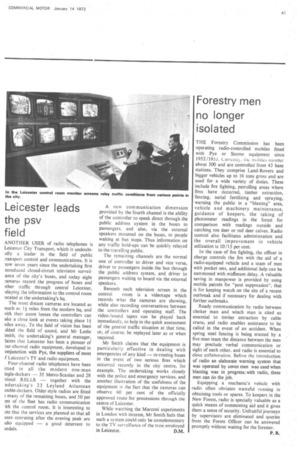Leicester leads the psv field
Page 43

If you've noticed an error in this article please click here to report it so we can fix it.
ANOTHER USER of radio telephones is Leicester City Transport, which is undoubtdly a leader in the field of public :ransport control and communications. It is :tow seven years since the undertaking first ntroduced closed-circuit television surveilance of the city's buses, and today eight am eras record the progress of buses and ither traffic through central Leicester, .elaying the information to the control room ocated at the undertaking's hq.
The most distant cameras are located as ouch as 1+ miles from the modern hq, and vith their zoom lenses the controllers can ake a close look at events taking place 1+ niles away. To the field of vision has been .dded the field of sound, and Mr Leslie lmith, the undertaking's general manager, laims that Leicester has been a pioneer of our-channel radio equipment, developed in ;onjunction with Pye, the suppliers of most f Leicester's TV and radio equipment.
Four-channel radio telephones have been itted in all the modern one-man ingle-deckers — 35 Metro-Scanias and 28 ristol RELLS — together with the ndertaking's 23 Leyland Atlantean ouble-deckers. Older-style radios are fitted t many of the remaining buses, and 50 per ant of the fleet has radio communication ith the control room. It is interesting to ote that the services are planned so that all uses operating after the evening peak are iclio equipped — a good deterrent to tndals.
A new communication dimension provided by the fourth channel is the ability Of the controller to speak direct through the public address system in the buses to passengers, and also, via the external speakers mounted on the buses, to people waiting at bus stops. Thus information on any traffic hold-ups can be quickly relayed to the travelling public.
The remaining channels are the normal one of controller to driver and vice versa, driver to passengers inside the bus through the public address system, and driver to passengers waiting to board via the external speakers.
Beneath each television screen in the control room is a videotape which records what the cameras are showing, while also recording conversations between the controllers and operating staff. The video /sound tapes can be played back immediately, to help in the quick assessment of the general traffic situation at that time, or, of course, be replayed later as or when required.
Mr Smith claims that the equipment is particularly effective in dealing with emergencies of any kind — re-routing buses in the event of two serious fires which occurred recently in the city centre, for example. The undertaking works closely with the police and emergency services, and another illustration of the usefulness of the equipment is the fact that the cameras can observe 60 per cent of the officially approved route for processions through the centre of Leicester.
While watching the Marconi experiments in London with interest, Mr Smith feels that such a system could only be complementary to the TV surveillance of the type employed in Leicester.
















































































































